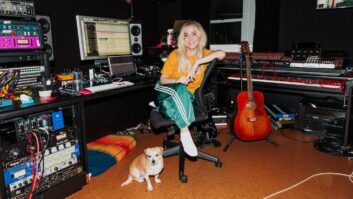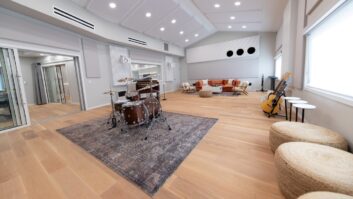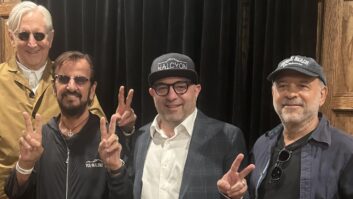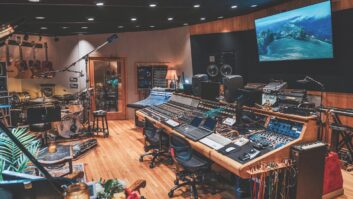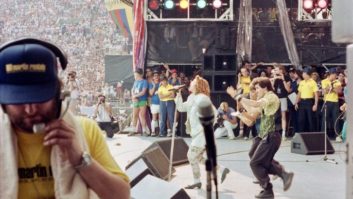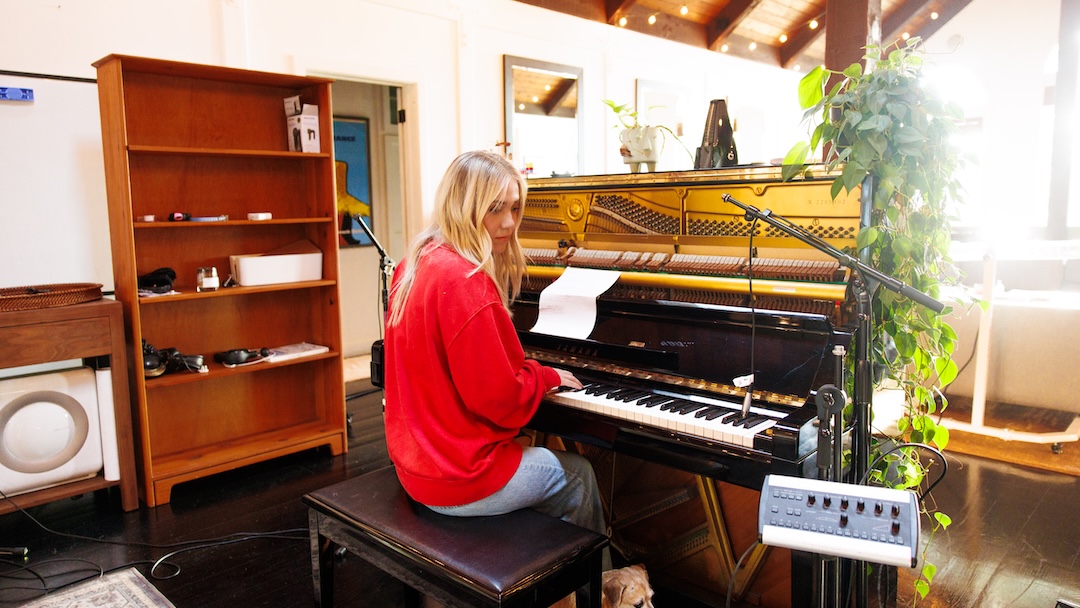
Don’t pass up Part 1, where Suzy Shinn shares how she broke into the industry, how her home/studio developed and more!
VOCAL PRODUCTION
Shinn has a knack for vocal production which became apparent early on in her career. At the home studio, she leans either on a CM7 or SM7. That goes through a TG2 or BAE, depending on how clean the vocal needs to be, then into a Purple 1176.
“There’s a bypass button on it so I can check my gain structure,” she says. “If I’m using the SM7, I’m generally using a Cloudlifter. I try not to compress too hard—three to five dB when I’m hitting.”
She has two approaches based on the song and the vocals. She comps as she goes or she comps later, which is dependent on the artist, the first take, how the song is broken down for recording, and if the artist knows the lyrics.
“If I’m comping as I go along, I go into freak mode,” she explains. “I hate the talkback button. A hundred percent of the time, in every session, you are not going to press the talkback button when someone’s talking; you’re going to miss it, and then you’re going, ‘Sorry, can you say that again?’ I also hate dead silence. I’m so fast because I hate the awkward silences. I have my SM7 on my desk as my talkback mic. It’s in input the entire time. I have a plug-in called Muteomatic—every time the music is playing, the mic is stopped, so as soon as the song stops, I can talk and be like, ‘That sounds sick. You want to do another?’ In that time, I’ve made a new playlist, and I’m ready to press Record.”
Once she has the take she likes, she’ll make a verbal and written note of the number, then do two more. She pulls the one she likes best to a new track labeled, for example, as verse box one, verse box two, chorus box one. Once she has the lead, she doubles that until it sounds right, then triples it until she has her rough comp. In addition, she has two or three “security takes” in case she needs to pull a word or do more tweaking. She makes cuts in the takes as markers to help her remember which she preferred.
“I’ll usually have some kind of rough chain on it,” she says. “I’ll use iZotope RX to get all the mouth clicks out of the way. I’ll make sure the breaths sound good. Maybe it needs a little Autotune. Sometimes it needs nothing at all, like Modest Mouse, but most likely, I put it into Melodyne and I tune it by hand.
“If you think about it, only vowels are sung. Consonants shouldn’t be tuned. They should be untouched. The breath should be untouched. I cut every vowel, and I tune the vowels that need to be tuned. That’s the long process, but I’m the imperfect perfectionist. There’s still an art form there for me, and I take pride in knowing I can get a million-dollar vocal.”
FREAKIER FRIDAY
Shinn’s vocal producing experience came in handy when she was tapped to produce the on-screen songs for Freakier Friday by producer Andrew Gunn, who also produced Freaky Friday (2003). The song “Take Me Away” from the 2003 film is reimagined for the new film, produced by Shinn, as are two original songs: “One Fine Day” written by Jason Evigan and Natania Lalwani, and “Baby” written by Sarah Aaron.
There are multiple versions of the latter in the film. As a song that Lindsay Lohan’s character writes, there is a demo version that is a rough acoustic iPhone voice note style, a big on-screen rock version and an indie/acoustic version.
“We have one version that I whipped up so fast,” says Shinn. “Nisha [Ganatra], the director, was like, ‘I want to put “Baby” in the scene where Lindsay’s surfing. Can you slow it down like this Billie Eilish song.’ It was 40 bpm slower. And I was like, ‘No, I can’t. It’s going to sound insane.’ Before the next day when she went back in to keep editing the movie, I made something where I sang it and did a very ballad-y version.
“Two weeks later, they’re doing strings for the whole score. The composer, Amie Doherty, is at the lot with a massive orchestra, and they’re putting strings on the song that I whipped up in one night. There’s an orchestra playing this piece of music I made with my voice. That was a very surreal moment.”
MODEST MOUSE
Modest Mouse’s Isaac Brock came to Shinn’s studio for a few days, but mostly she worked with him in Portland, Oregon. From December 2024 to April 2025, every few weeks, Shinn would travel to his Ice Cream Party Studio for a week.
Prior to working with Shinn, Brock had jammed with his band and done some writing with Jacknife Lee (U2) and Justin Raisen (Kim Gordon, Magdalena Bay), resulting in an array of material—jams, interludes, 40-second songs and six-minute songs. Shinn had to keep things moving, comping as they were doing the tracking live. She would bring the recordings back to her home studio in between Portland visits and make bounces to determine the next steps.
On “Impossible Somedays,” there is a guitar that sounds like a talkbox—a Korg Miku Stomp pedal which emulates Hatsune Miku singing. “She says different phrases based on what you play into it, like an anime pedal,” Shinn explains, “and he’s playing it in time. There’s a big latency, so it’s crazy how you have to play to get it to lock into time. That part of the song was supposed to be gone at one point, and I was like, ‘I don’t know, it’s pretty cool and weird and sad and different.’”
JACK’S MANNEQUIN
Shinn had worked with Andrew McMahon of Jack’s Mannequin on “New Year’s Song,” released on January 1, 2021. He came back to her with the idea of re-creating Jack’s Mannequin’s seminal 2005 album, Everything in Transit, for its 20th anniversary. The original was produced by Jim Wirt and McMahon. It features Tommy Lee on drums and was mixed by Chris Lord-Alge.
Shinn knew the album by heart—sometimes recalling the lyrics quicker than McMahon. The concept for the new version was to play everything on a miked instrument. If any synths were used, they had to have a speaker and be battery-powered. No DI and nothing plugged into electricity—with the exception of a Mellotron cello sound on a few of the songs. They didn’t rework every song from Everything in Transit, but in a two-week period, they did enough for a five-song EP.
“We used the piano upstairs,” Shinn says. “I got poster tack. I got blue masking tape. I got eraser heads. We had all kinds of things and treated the piano to make it sound different, including running it through guitar pedals. I had my friend Allie Stamler, who’s an amazing violinist, come in with no parts written, with me and Andrew singing what we wanted her to do. We would build a little section, then pitch the violin down an octave to make it sound like a cello. We used a Mellotron cello sound, building, doubling it, quadrupling it.
Discover more great stories—get a free Mix SmartBrief subscription!
“I recorded the room for every piano part, every vocal part,” she continues. “If we didn’t record the room, then I would re-send the vocal back up through a speaker, and then re-amp the room. We had Drew Tachine come in and play drums with chopsticks on one song—literal chopsticks.”
With all the demands on her time and for her skills, Shinn still fits in projects that touch her musically and personally, like Kid Sistr, for which there is no budget, but there is endless enthusiasm, plus talent and genuine friendship. She treats it with the same level of attention as her high-profile projects.
“I don’t put anyone on a pedestal,” she says. “You’re just a human who did some cool human things that humans are capable of doing. We’re hanging. I don’t do anything special, but I don’t do anything crazy. I stand my ground, though. If you go off on me, I’m not going to go off back. But I’ll be like, ‘I think we’re good for today, but we can pick it up tomorrow.’”
